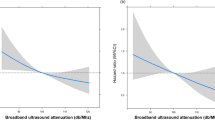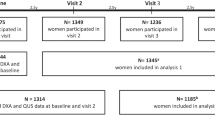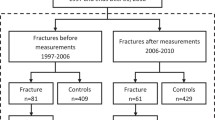Abstract
Summary
In a cohort of 5,201 women [72.3 ± 5.3 years] from 58 primary care centers in Spain, followed for three years, no relationship between heel QUS parameters and overall mortality was found. However, a significant relationship between a low speed of sound (SOS) and vascular mortality was observed.
Introduction
An inverse relationship between mortality and bone mineral density measured by dual-energy absorption densitometry or quantitative bone ultrasound (QUS) has been described. The aim of the present study was to test this relationship in the ECOSAP cohort, a 3-year prospective study designed to assess the ability of heel QUS and clinical risk factors to predict non-vertebral fracture risk in women over 64.
Methods
A cohort of 5,201 women [72.3 ± 5.3 years] was studied. QUS was assessed with the Sahara® bone sonometer. Women attended follow-up visits every 6 months. Physicians recorded if the patient died and cause of death. Hazard rates (HR) of all-cause and vascular mortality per one standard deviation reduction in QUS parameters were determined.
Results
One hundred (1.9%) women died during a median of 36.1 months follow-up, for a total of 14,999 patient-years, 42 because of vascular events (both cardiovascular and cerebrovascular). After adjusting for age, none of the QUS variables showed statistically significant differences between the patients who died and the survivors. In the final multivariate model, adjusted for age, current thyroxine and hypoglycaemic drug use, chronic obstructive pulmonary disease and decreased visual acuity, SOS was marginally non-significant: (HR: 1.19; 0.97–1.45). However, each 1 SD reduction in SOS was associated with a 39% increase in vascular mortality (HR: 1.39; 1.15–1.66).
Conclusions
In our cohort, SOS was related with vascular mortality, but not overall mortality.

Similar content being viewed by others
References
Cooper C, Atkinson EJ, Jacobsen SJ, O'Fallon WM, Melton LJ 3rd (1993) Population-based study of survival after osteoporotic fractures. Am J Epidemiol 137:1001–1005
Kado DM, Browner WS, Palermo L, Nevitt MC, Genant HK, Cummings SR, Osteoporotic Fractures Research Group (1999) Vertebral fractures and mortality in older women: a prospective study. Arch Inter Med 159:1215–1220
Jalava T, Sarna S, Pylkkanen L, Mawer B, Kanis JA, Selby P, Davies M, Adams J, Francis RM, Robinson J, McCloskey E (2003) Association between vertebral fracture and increased mortality in osteoporotic patients. J Bone Miner Res 18:1254–1260
Johnell O, Kanis JA, Oden A, Sernbo I, Redlund-Johnell I, Petterson C, De Laet C, Jonsson B (2004) Mortality after osteoporotic fractures. Osteoporos Int 15:38–42
Empana JP, Dargent-Molina P, Bracart G, EPIDOS Group (2004) Effect of hip fracture on mortality in elderly women: the EPIDOS prospective study. J Am Geriatr Soc 52:685–690
Hasserius R, Karlsson MK, Jonsson B et al (2005) Long-term morbidity and mortality after a clinically diagnosed vertebral fracture in the elderly: a 12- and 22-year follow-up of 257 patients. Calcif Tissue Int 76:235–242
Browner WS, Seeley DG, Vogt TM et al (1991) Non-trauma mortality in elderly women with low bone mineral density. Study of Osteoporotic Fractures Research Group. Lancet 338:355–358
Johansson C, Black D, Johnell O et al (1998) Bone mineral density is a predictor of survival. Calcif Tissue Int 63:190–196
Kado DM, Browner WS, Blackwell T et al (2000) Rate of bone loss is associated with mortality in older women: a prospective study. J Bone Miner Res 15:1974–1980
Trivedi DP, Khaw KT (2001) Bone mineral density at the hip predicts mortality in elderly men. Osteoporos Int 12:259–265
Marín F, González-Macías J, Díez-Pérez A et al (2006) Relationship between bone quantitative ultrasound and fractures: a meta-analysis. J Bone Miner Res 21:1126–1135
Turner CH, Peacock M, Timmerman L et al (1995) Calcaneal ultrasonic measurements discriminate hip fracture independently of bone mass. Osteoporos Int 5:130–135
Schott AM, Weill-Engerer S, Hans D et al (1995) Ultrasound discriminates patients with hip fracture equally well as dual energy X-ray absorptiometry and independently of bone mineral density. J Bone Miner Res 10:243–249
Bouxsein ML, Radloff SE (1997) Quantitative ultrasound of the calcaneus reflects the mechanical properties of calcaneal trabecular bone. J Bone Miner Res 12:839–846
Bauer DC, Palermo L, Black D et al (2002) Quantitative ultrasound and mortality: a prospective study. Osteoporos Int 13:606–612
Pinhero MM, Castro CM, Szejnfeld VL (2006) Low femoral bone mineral density and quantitative ultrasound are risk factors for new osteoporotic fracture and total and cardiovascular mortality: a 5-year population-based study of Brazilian elderly women. J Gerontol A Biol Sci Med Sci 61:196–203
Díez-Pérez A, González-Macías J, Marín F et al (2007) Prediction of absolute risk of non-spinal fractures using clinical risk factors and heel quantitative ultrasound. Osteoporos Int 18:629–639
Hernández JL, Marín F, González-Macías J et al (2004) Discriminative capacity of calcaneal quantitative ultrasound and fracture risk factors in postmenopausal women with osteoporotic fractures. Calcif Tissue Int 74:357–365
von Stetten E, Ouellet H, Wilson KE et al (1998) European caucasian female reference data values for the Sahara clinical bone sonometer. Bone 23(Suppl 5):S637 Abstract
Marín F, Vila J, González-Macías J, on behalf the ECOSAP project investigators (2003) Quantitative bone ultrasound: impact of the application of two different reference databases to a population of 5195 postmenopausal women. Med Clin (Barc) 121:250–252
Sosa M, Saavedra P, Muñoz-Torres M et al (2002) Quantitative ultrasound calcaneous measurements: normative data and precision in the spanish population. Osteoporos Int 13:487–492
Lin J, Zhang D, Davidian M (2006) Smoothing Spline-based score tests for proportional hazards models. Biometrics 62:803–812
R Development Core Team (2006) R: A language and environment for statistical computing. R Foundation for Statistical Computing, Vienna, Austria. Available at: http://www.R-project.org, accessed: 29 December, 2007
von der Recke P, Hansen MA, Hassager C (1999) The association between low bone mass at the menopause and cardiovascular mortality. Am J Med 106:273–278
Mussolino ME, Madans JH, Gillum RF (2003) Bone mineral density and mortality in women and men: the NHANES I epidemiologic follow-up study. Ann Epidemiol 13:692–697
van der Klift M, Pols HAP, Geleijnse JM et al (2002) Bone mineral density and mortality in elderly men and women: the Rotterdam study. Bone 30:643–648
Browner WS, Pressman AR, Nevitt MC et al (1993) Association between low bone density and stroke in elderly women. The study of osteoporotic fractures. Stroke 24:940–946
Uyama O, Yoshimoto Y, Yamamoto Y et al (1997) Bone changes and carotid atherosclerosis in postmenopausal women. Stroke 28:1730–1732
Jorgensen L, Engstad T, Jacobsen BK (2001) Bone mineral density in acute stroke patients: low bone mineral density may predict first stroke in women. Stroke 32:47–51
Tanko LB, Bagger YZ, Christiansen C (2003) Low bone mineral density in the hip as a marker of advanced atherosclerosis in elderly women. Calcif Tissue Int 73:15–20
Tanko LB, Christiansen C, Cox DA et al (2005) Relationship between osteoporosis and cardiovascular disease in postmenopausal women. J Bone Miner Res 20:1912–1920
Johnell O, Kanis JA, Oden A et al (2005) Predictive value of BMD for hip and other fractures. J Bone Miner Res 20:1185–1194
Stewart A, Kumar V, Reid DM (2006) Long-term fracture prediction by DXA and QUS: a 10-year prospective study. J Bone Miner Res 21:413–418
World Health Organization. http://www.who.int/countries. Accessed: 18 January 2008
Bauer DC, Rodondi N, Stone KL et al (2007) Thyroid hormone use, hyperthyroidism and mortality in older women. Am J Med 120:343–349
Acknowledgements
We thank Mar Nieva, Mª Angeles Valero, Elena Arriaza, and Ana Carla Franch, Department of Medical Research, Eli Lilly and Company, Madrid (Spain), for the study monitoring, and Sergi Mojal, Institut Municipal d’Investigació Mèdica (IMIM), for statistics programming.
Funding
This study was supported by an unrestrictive research grant from the Medical Research Department, Eli Lilly and Company, Madrid. Spain.
Conflicts of interest
Dr. Fernando Marín is an employee of Eli Lilly, a company that investigates and commercializes bone active drugs. All other authors have no conflicts of interest.
Author information
Authors and Affiliations
Consortia
Corresponding author
Additional information
For a complete list of ECOSAP investigators, see Appendix.
Appendix
Appendix
*ECOSAP study investigators:
M.S. Arenas (C.S. La Florida. Alicante); J. Gálvez, E. Mira (C.S. Los Ángeles. Alicante); V. Borreguero, M.A. Cabrera, P. Aceña (C.S. El Pla Hospital. Alicante); R. Berenguer, A. Cebreiro, M. Puchades, J. Cantero (C.S. Algemesí-Alfafar. Valencia); R. González, M.L. Altarriba, A. García-Royo (C.S. Salvador Pau. Valencia); M.A. Fortea, M.A. López (C.S. Campanar. Valencia); A. Gimeno, Z. Pla (C.S. La Alcudia. Valencia); C. Alfonso, B. García-López (C.S. San Andrés. Murcia); J.E. Carrasco, J. Aliaga (C.S. Abarán. Murcia); S. Giménez (C.S. Ciudad Jardín. Málaga); J.A. Godinez (C.S. Antequera. Málaga); S. Alvarez (C.S. Las Albarizas. Marbella); F. Ruiz (C.S. Las Lagunas. Mijas Costa); R. Moya, M.A. Martín, M.M. Pérez, R. Vera (C.S. Cerro del Águila. Sevilla); T. Guerrero, H. Sánchez (C.S. Fuensanta. Sevilla); J. Calvo, J.A. Alameda (C.S. El Molino de la Vega. Huelva); B. Galán (C.S. Fuente Palmera. Córdoba); D. Martín (C.S. Torredelcampo. Jaén); J.A. Castro (C.S. Cartuja-Almanjayar. Granada); J.J. Rascón, P. Arqueros (C.S. Ciudad Jardín. Almería); J. Brunet, J. Comerma (ABS Sant Llatzer. Terrassa); C. Rubio, S. Cañadas, M. Berenguer (ABS Florida Nord. Hospitalet); L. Gayola (ABS Florida Sur. Hospitalet); R.M. Alcolea, T. Rama (ABS Llefiá. Badalona); J.J. Montero (ABS Ronda Prim. Mataró); E. Marco(ABS Sarriá de Ter. Girona); C. Carbonell, A. Cama, C. Olmos (ABS Vía Roma. Barcelona); R. Villafáfila, C. Bentue (ABS Viladecans II. Barcelona); G. Amorós, E. Barraquer (CAP Horta Lisboa. Barcelona); M.B. Brun (CAP Montcada i Reixac. Barcelona); M. Abizanda, A. Cervera (CAP Gran Vía. Barcelona); E. Santos, M. Turégano (C.S. Zona Centro. Cáceres); M. Espigares, J. Pozuelos (C.S. La Paz. Badajoz); G. Rodríguez, J.M. Comas (C.S. Puebla de Montalbán. Toledo); E. Magaña, J. Pérez (C.S. Estación “Paseo del Muelle”. Talavera de la Reina); F. Chavida, C. Cancelo (C.S. Brihuega. Guadalajara); F. Laporta (C.S. La Roda. Albacete); D. Zapatero, M. Sanz, A.C. García-Alvarez (C.S. Avda. de Daroca. Madrid); R. Julián, M.V. Castell (C.S. Peñagrande. Madrid); A. Morón (C.S. El Abajón. Madrid); J.C. Muñoz, S. Tojeiro (C.S. San Fernando. Madrid); M.L. Pascual, I. Nieto (C.S. Paseo de la Chopera. Madrid); J.A. Granados, F. Gómez (C.S. Guayaba. Madrid); O. Ortega, I. Jimeno (C.S. Isla de Oza. Madrid); C. Cámara (C.S. Coronel de Palma. Madrid); C. Onrubia, R. Martín (C.S. José Aguado. León); M. Borge, C. Gago (C.S. Arturo Eyres Sur. Valladolid); E. Blanco (C.S. Béjar. Salamanca); F. Suárez (C.S. Sur Paulino Prieto. Oviedo); P. Benavides (C.S. Pumarín. Oviedo); R. Villanueva, J.C. de la Fuente (C.S. García Alonso “Bombero Etxaniz”. Bilbao); E. Sampedro, V. Rubio (C.S. Hermanos Iturrino. Irún); M.C. Napal, J.A. Tabar (C.S. Barañain. Navarra); M.D. Martínez (C.S. Rochapea. Pamplona); T. Sagredo, F.E. Teruel (C.S. Txantrea. Pamplona); M. Flores (C.S. Espartero. Logroño); L.V. Hernández, F. Aganzo (C.S. La Almunia. Zaragoza); R. Córdoba, G. Guillén, E. de la Figuera (C.S. Delicias Sur. Zaragoza).
Rights and permissions
About this article
Cite this article
González-Macías, J., Marín, F., Vila, J. et al. Relationship between bone quantitative ultrasound and mortality: a prospective study. Osteoporos Int 20, 257–264 (2009). https://doi.org/10.1007/s00198-008-0645-8
Received:
Accepted:
Published:
Issue Date:
DOI: https://doi.org/10.1007/s00198-008-0645-8




